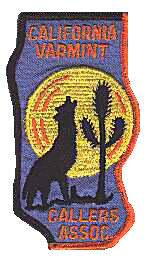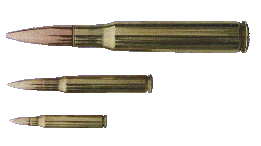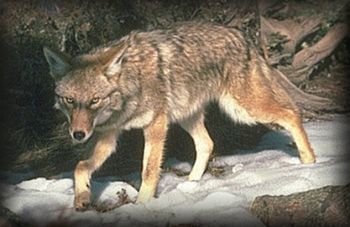|
The California
Varmint Callers Association
The first varmint hunting site on the net! The California Varmint Callers maintains this webpage for the benefit of all varmint and predator hunters.
|
||
|
|
Uncle John on Long Range Shooting
I am, and have been since age 5, a rifleman. As soon as I was able to bear arms (lift a little turn of the century Winchester pump .22) I began testing the limits.

First shot hits at long range with any rifle are never a sure thing, regardless of the BS you read. Tactical shooting is a very popular topic now. One reads about the "schools for this, and the military and police competitions held. One old time shooter, who originated on the east coast, rather famous for his shooting and instruction of shooters, recently stated: "Those military and police snipers would not last an hour in the field against my neighbors here in Montana." There is absolutely no substitute for EXPERIENCE. All the ballistic tables and computer programs in the world will not make you a long-range shooter. They can be a help to the experienced rifleman. But he will still outshoot the modern "tactical shooter" without them.

First, the choice of rifles. Some of the best of modern military semi autos shoot pretty well. They are used in modern matches either because the demands of the match dictate it in terms of speed or rules. Mostly they are used because the participants are familiar with that particular configuration of firearm from military experience. None of them are as good as a really fine bolt rifle. That is because there is too much mechanical activity, and because they are awkward to hold. Semi autos are made for volume fire, with accurate fire a secondary objective. The choice of caliber often is more a matter of military requirements, and familiarity, than a choice of the best.
When the objective is to make a hit at very long range, there are only two
considerations. First, is the most accurate rifle you can obtain. This includes
a very high quality scope of high resolution and
The rifle itself should be of select match quality, bolt action, with a generous stock that adapts itself to various situations. A flat fore end, and if it is thumbhole, it should also be designed to make a fast grasp over the grip. RICHARDS MICRO FIT provides such stocks in laminated wood. I prefer these. Another great choice is a synthetic by H&S Precision. Second, the caliber should be one that has sufficient case capacity to propel your selected bullet at greater than 3000 fps. The caliber should not be so great as to cause discomfort in long, yes long, practice sessions. The bullet should be of relatively heavy weight for the caliber. Not extreme. It should have a very good ballistic coefficient. Now take care in applying this information. Yes a 220 grain bullet out of a 300 Win Mag has plenty of BC. It will also kick the heck out of you. It will ruin you for really accurate shooting.
The use of very light (low BC) bullets at hyper velocity is counter productive for long range. The scope for long range shooting must have an easily read top turret, to quickly adjust for drop. Since I use several rifles, I need notes on a piece of tape on the bottom of my stock to remind me of proper settings for various ranges. If you shoot only one rifle, you may not need such a reminder. Some of my scopes have range marks on the turret that correspond to actual ranges. (Redfield Illuminator with Accutrak.) I find range indicators within the scope (mildots, and the double reticules that fit certain objects at specified ranges) to be little help to an experienced rifleman, absolutely NO help to the novice. They are distractions. For the experienced rifleman, a duplex reticule helps in making hold offs on a quick second shot, but not for estimating the correct hold on the first. Therein is another reason to use care in selecting a caliber of mild recoil. You should be able to see your bullet strike through the scope to make correct adjustments after a miss. A good rangefinder is the number one tool of the modern day. Load development can be done at a hundred yards. The goal is accuracy, of course. But it MUST be done over a chronograph. Even though a load is very accurate at 100 yards, velocity variation is your enemy at long range. Go for a load with very small standard deviation of velocity. The lower you can get it, the better. Velocity variation at long range can drive you as crazy as wind drift. Depending on your target, a first shot hit may or may not be crucial. For prairie dogs, you can use the following method: Without a range finder, make your best guess at the range, and adjust the top knob for that range. Use Kentucky windage. Mark in your mind the position of the target on your duplex reticule. Both of these guesses should be based on a lot of shooting experience with THAT load. If you miss, adjust the scope for range, first. This is done by holding the scope on the TARGET and moving the top knob up or down to put the horizontal cross hair on the bullet strike. Next, use hold off for the wind again. Hold off an equal distance to the opposite side of the bullet strike. (plus or minus your first hold off) Don't adjust the scope for wind. It will end up causing a lot of confusion. Pretty soon you will not know where that next shot at a different range and wind direction will land. You will be so confused you will have to resight the rifle under ideal conditions. Not something you can do in the field.
Accurate wind drift charts may be of some aid at this point. But it all comes down to experience and good judgment. If you want to get good, shoot, shoot, shoot. Good luck. Any questions? Guest article written by Uncle John and submitted by David Buchman. David can be reached at [email protected]
|
|


 The weight of the bullet,
in itself, does NOT help wind drift. Wind drift is in direct proportion to
VELOCITY LOSS. In other words, in inverse proportion to ballistic coefficient.
A 17 caliber bullet will not drift any more than a 30 caliber bullet IF the
velocity and ballistic coefficient are the same. (Typically, this is not
the case.)
The weight of the bullet,
in itself, does NOT help wind drift. Wind drift is in direct proportion to
VELOCITY LOSS. In other words, in inverse proportion to ballistic coefficient.
A 17 caliber bullet will not drift any more than a 30 caliber bullet IF the
velocity and ballistic coefficient are the same. (Typically, this is not
the case.)
 Now, to get
a little more modern, and to give you a better chance of a first shot hit,
very important for larger, more mobile varmints like coyotes, use a laser
rangefinder. You will need to know at exactly what setting to turn your top
knob to for every range, in 100 yard increments for about the first 400 yards,
50 yard increments out to about 600 yards, and 25 yard increments for ranges
out to about a thousand. You may need notes taped to the rifle for this.
Now, to get
a little more modern, and to give you a better chance of a first shot hit,
very important for larger, more mobile varmints like coyotes, use a laser
rangefinder. You will need to know at exactly what setting to turn your top
knob to for every range, in 100 yard increments for about the first 400 yards,
50 yard increments out to about 600 yards, and 25 yard increments for ranges
out to about a thousand. You may need notes taped to the rifle for this.